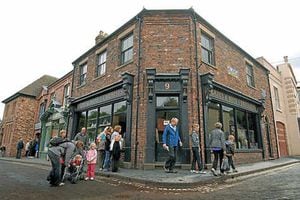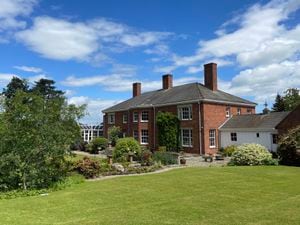31 great days out in Shropshire - Days 4 and 5
It may not have Alton Towers, but Shropshire is a rural county full of quiet thrills. Ben Bentley launches a month-long campaign to highlight the region's many family-friendly attractions. Click here for an overview of the great days out campaign and check back each day for the latest idea.

It may not have Alton Towers, but Shropshire is a rural county full of quiet thrills. Ben Bentley launches a month-long campaign to highlight the region's many family-friendly attractions.
Click here for an overview of the great days out campaign and check back each day for the latest idea to keep the family entertained this August.
See the latest Great Days Out here.
Day 5: The Stiperstones
Where is it? Near Minsterley. Car parks on the site of the former Bog Mine (SO 357978) and a National Trust car park just north of the road to Bridges (SO 370977).
What is it? One of Shropshire's most spectacular landscapes, this hill and ridge is a National Nature Reserve in the Shropshire Hills and an Area of Outstanding Beauty. And for the record, she is properly a thing of great beauty and intrigue, is the Stiperstones.
And at 536 metres above sea level, it is the second highest hill in the county, surpassed only by Brown Clee Hill at546 m. Visible for miles around, Stiperstones' five-mile long summit ridge is crowned by several rugged, jagged outcrops of rock silhouetted against the sky.
How much is it? Priceless. Free to visit, however.
What is there to do? Put everything literally into perspective by clambering to the top of the ridge and admiring the views of Shropshire from the best seat in the house – the Devil's Chair. This is just one of the outcrops which characterise the ridge.
This is about as far away from organised entertainment as you can get – so just make up your own. Go wild in the countryside or fly a kite. Spoil yourself and have a picnic in the sky. This is proper walking country, but there are paths and you can go at your own pace.
The landscape is wild, rugged and atmospheric, and has a geology of national significance. The 'Stiperstones Quartzite', which makes up the ridge was shattered during the last Ice Age to create the jagged, boulder-strewn landscape that characterises the area today.
Lovers of wildlife will be in their element because the reserve is a place that myriad of species call home. Expect to meet a common frog live on the reserve. Local birdlife includes red grouse, red kite, skylark, raven and stonechat. Of your favourite invertebrates, say hello to hairy wood ants, magnificent green hairstreak butterflies and emperor moths.
Far away from the bustle of civilisation, you might not see anyone for miles, so prepare for your visit with this in mind. Nearby you can visit the Bog Visitor Centre (six miles north of Bishop's Castle, east of the A488), or pop for a lunch and a pint at the Stiperstones Inn (postcode SY5 0LZ, phone 01743 791327).
Interesting 'fact': According to legend the rocks of the Devil's Chair were brought there by the Devil himself; he dropped them when he fancied a rest. Of course, this was in the days before fold-out deck chairs . . .
Verdict: A great wholesome day out for all the family in the great outdoors, particularly for children. Wise to wear sturdy boots and sensible clothes as the terrain is changeable to say the least.
Day 4: Whittington Castle
Where is it? Castle Street, Whittington, Oswestry SY11 4DF.
How much is it? Free entrance, but £1 to park via pay and display machine.
What is it? Whittington Castle is the only community run castle in the country and is a historic moated ruined castle. The iconic Gatehouse is much photographed and still has evidence from the time that the castle was fortified, with marks where guards would have sharpened their swords and weapons. This powerful Marcher castle was a basic training camp where men were trained as guards, squires and knights to defend this border region.
What is there to do? An ideal family day out with a large calendar of events from medieval re-enactments, plant fairs, car boot sales, craft fairs to paranormal investigations. You can also feed the ducks, wander the grounds or sip tea in our tearoom.
The viewing mound looks down on what was a magnificent medieval garden and harks back to the time when the wars had ceased and Lady Eleanor turned the castle into a family home.
Inside the Tudor cottage you can see the medieval well which has been covered over in glass, and visit the guardroom which looks like a dungeon and imagine being put in the stocks and chains.
Visitors can wander the castle grounds and imagine life as it would have been and learn about the castle through its interpretation panels.
Children can pretend to be guards on the bridge and play games in the castle keep, or even put someone in the pillory.
Many visitors come to the castle to see the wildlife on site. You can also book a guided tour or Knight or Princess Party and organise school visits. It is also a romantic ruin, licensed for civil ceremonies, which makes the ideal setting for a wedding. The castle is said to have ghosts and is a popular haunt of ghost hunters.
Interesting fact: Castle manager Sue Ellis says: "Did you know that the castle was once home to Shropshire's very own Robin Hood – Fulk Fitzwarine III who was outlawed by King John and lived in the forest with his brothers until he was pardoned and gained the castle?" We do now.
Opening times: Open all year Wednesday to Sunday (open Bank Holiday Mondays), 10am-4pm.
Verdict: Whittington Castle is the ideal family day out. Kids will love playing in the grounds.
Further Information: Visit: www.whittingtoncastle.co.uk Or call 01691 662500.
Day 3: Royal Air Force Museum Cosford
Where is it? Between Albrighton and Shifnal, TF11 8UP (J3 of the M54 motorway along the A41).
What is it? The RAF Museum Cosford has 70 historic aircraft on display in three wartime hangars and within The National Cold War Exhibition.
A major feature of this unique exhibition is Britain's three V-Bombers: Vulcan, Victor and Valiant.
A number of aircraft are suspended in flying attitudes with interactive kiosks and audio visuals telling the story in a fun and innovative way.
How much is it? Free.
What is there to do? Prepare to be amazed . . . The National Cold War Exhibition is a landmark building containing 18 aircraft, military transport, missiles, memorabilia, and interactive kiosks, reflecting the social, cultural and political history of the Cold War era in a fun and innovative way.
Many of the suspended aircraft including a Dakota, Canberra, Meteor, Lightning and Javelin can be viewed from an elevated viewing gallery. Audio visual hotspots focus on key aspects of the Cold War including the Space Race and Cuban Missile Crisis.
As well as the aircraft on display at Cosford which include the unique TSR2 and the world's oldest Spitfire, the RAF Museum Cosford is home to a number of smaller unique exhibitions such as the Lucky Mascots exhibition and the RAF Boy Entrants permanent exhibition.
RAF Museum Cosford is one day out that everyone will enjoy whatever the weather. And children and adults will be fascinated by the fun 'n' flight activities.
Packed with hands-on excitement, it's the easy way to answer all those questions about how aircraft stay up in the air. Whether you're investigating airflow with 'The Blower' or guiding a Hercules to a drop zone, you will be learning and having fun.
The advanced flight simulator is also a great way to get an instant flying experience – soar into the sky with the Red Arrows or ride in a Eurofighter, the most advanced aircraft ever built.
Interesting facts: The Valiant XD818 on display at the museum dropped Britain's first live H-bomb, weighing 10,000lb, off Malden Island in 1957. The museum is also home to the world's oldest Spitfire. Of the 1,566 Spitfire's built, the Supermarine Spitfire I on display at the Museum is the oldest surviving example of its type.
Opening times: Open daily from 10am to 6pm (last admission 5.00pm).
Verdict: Hard to believe it's free – here's a day that will truly fly by!
Further information: For the latest news and event information visit the Museum website at www.rafmuseum.org or telephone 01902 376200.
Day 2: Attingham Park
Where is it? Atcham, near Shrewsbury, SY4 4TP.
What is it? A bit of a county treasure, this one. An impressive stately home, Attingham Park was built for the 1st Lord Berwick in 1785 and was in continuous ownership by the family for more than 160 years. Set in spectacular grounds on the River Severn.
How much is it? Free for National Trust members and under-5s, or adult £9.90, child £5.80, family ticket £22.
What is there to do? As with many National Trust properties, you take your pick on whether your visit is educational or fun, or a bit of both.
A visit to the mansion is a must for those who have never been before. See how the family would have lived and worked on a tour around many 'set-piece' rooms.
There re often hands-on activities for the kids, particularly in the kitchens, which would have been part of the servants' quarters.
The other great thing about Attingham today are the volunteers who help keep the show on the road. Try to flummox them with a question about the house. If they don't know the answer, they will find someone who will. Top of the class.
Also for August, there's a fun packed range of activities to keep young visitors happy every day during the school holidays, with special event days every Tuesday and acres of green fields and woodland to let off steam and relax in.
Visit the tranquil Walled Garden to catch-up on what's harvesting this month (and to visit the pigs!). The kids can let off a bit more steam in the play area while adults get their breath back.
Enjoy a walk along the river or through the woods. And then round off the day with a nice cup of tea and slice of cake! How very British, what?
Interesting fact: The exhibition Hidden Lives: Royalty, Glamour and War contains the family coronation robes and other beautiful items that haven't been seen before.
Opening times: Park, café, bookshop, play field and Walled Garden open 9am to 7pm, mansion from 12.30pm to 5.30pm (last admission 4.30pm).
Verdict: What's the difference between fun and education? At Attingham Park it's pretty much the same thing. One for all ages, this, and a firm favourite amongst repeat visitors.
Further information: Visit www.nationaltrust.org.uk/attingham-park/ or contact 01743 708162.
Day 1: Much Wenlock Olympian Trail and Museum
Where is it? Starts at the Much Wenlock Museum and Visitor Information Centre, High Street, Much Wenlock, TF13 6HR.
What is it? What better way to bring to life the connections between this small market town and the Olympic Games than a visit to the place that has a claim on being the inspiration for the modern day Games.
The newly refurbished Much Wenlock Museum contains displays and a magnificent collection of Wenlock Olympian Society artefacts telling the story of the links between Dr William Penny Brookes and the modern Games.
The Olympian Trial also begins here, so step back in time to 1850 and walk in the footsteps of Dr Penny Brookes. Visitors follow a trail map, dropping by at locations of key people and places, including the former home of Dr William Penny Brookes, and the very sports field where the town's Olympian Games all started, to the rear of William Penny Brookes School.
Maps of the trail are available from the museum and visitor centre. The total walk length is approximately 1.3 miles and takes around 90 minutes, but visitors can do it as quickly or leisurely as they fancy.
How much is it? Free
What is there to do? Throughout the trail you will encounter information boards giving you more background on Dr Brookes and the Games. Waymarkers set into the ground also lead the way.
Apart from walking in the footsteps of Penny Brookes, visitors can stop off at the many shops and cafes and see the Raven Hotel where in 1890 Brookes staged pivotal talks with Baron Pierre de Coubertin, the organiser of an International Congress on Physical Education, which ultimately led to the rebirth of the Olympic Games.
Make a day of it and stop off for a picnic within the grounds of Wenlock Priory – it's not a sprint, remember, although in the Olympic spirit you might want to get a move on . . .
Interesting fact: The number of visitors to Much Wenlock to see the place that was the inspiration for the modern Olympics has doubled this year. TV crews from around the world have, including those from Australia, Poland and New York have made a beeline. You're next . . .
Opening times: 10.30am to 1pm and 1.30pm to 4pm daily.
Verdict: An informative and engaging trail that brings to life Much Wenlock as the inspiration for the modern Olympic Games.
Further information: Visit www.muchwenlockmuseum.co.uk or contact 01952 727679.





